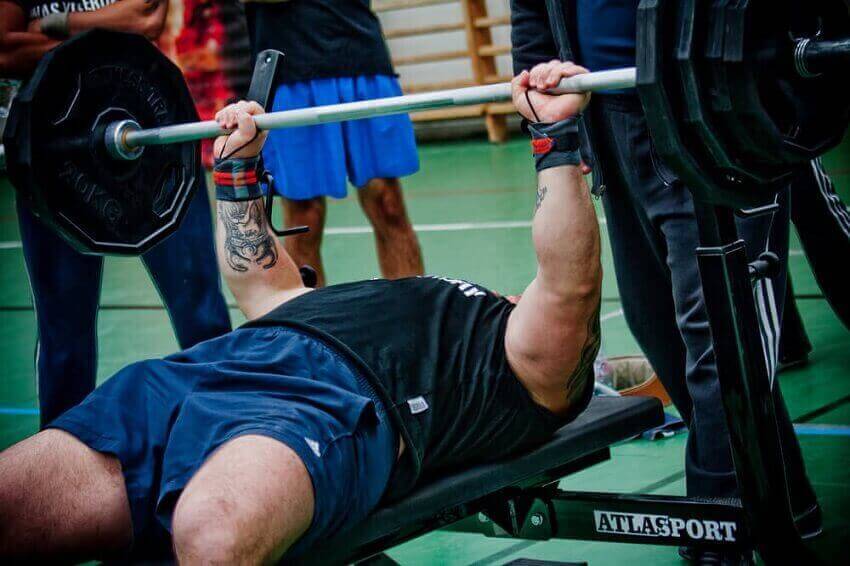
Over the years at the gym I have been lucky enough to workout with all variety of athletes. From hilariously in-shape pro athletes and Olympians to “hey, round is a shape!” friends looking to get fit again after a long layoff.
And while the two groups may be miles apart in terms of goals in when it comes to spending time in the gym, inevitably their focus intersects with the desire to bench press well.
Although they may fuss over being able to bench big numbers, the real secret to building a scary bench is being able to do it correctly.
Sure, throwing a couple extra plates while forsaking form and technique might earn you a temporary jolt of pride in the gym and in your log book, but over the long run poor form will lead to injury and also limit the progress you can make under the bar.
In this little guide we have 5 specialists, from strength coaches to sports chiropractors, stopping by to dish on 5 common bench press mistakes people make at the gym, and how to go about fixing them.
Let’s do this!

1. Going Footloose with your lower body.
Yeah, we know. The bench press is predominantly an upper body exercise.
It’s tempting to think that it only targets your chest and shoulders, but your core, your back, and yes, even your lower body play a role in how much weight you are able to throw up (down?) when you slide up on the bench.
When the strain becomes too much you’ll see a lifter begin to squirm around, wiggling, with their feet beginning to loosen from the screwed in position they started out with.
Catherine King, BHK, MSc., CSCS, of West Coast Conditioning emphasizes that when your feet begin to shift around you are shorting the amount of torque you can produce under the bar:
If you are going to dance your feet around when you bench press, you may as well just dance at home.
The net effect is that you are robbing yourself of stability and the ability to produce power. Place your feet wide and pull them underneath you.
Drill your feet into the floor to firmly anchor them. This grounding into the floor stabilizes and increases your ability to link kinetically for a more powerful bench press.
Plant your feet, and watch your bench press grow. (Plant metaphor!)
2. Not incorporating dumbbells into your benching routine.
If you are like me using dumbbells at the gym for bench is often born out of necessity. With the classic benches almost always being taken up and my lack of patience I will head over to the free weight area and throw down on some dumbbells. I like the versatility that comes with them.
You can get a more neutral grip, or as I like to do, perform single arm alternating bench to really target my core and stabilizing muscles.
Paul Hunter, CSCS, MATjs, and owner of Grayton Beach Fitness acknowledges the positive aspects of using dumbbells vs. barbell for bench in terms of both stimulation of the stability and core muscles, as well as the injury prevention aspects of using DB’s:
The next time you do bench try using dumbbells, all the while not allowing the elbows to go below the shoulder.
Using dumbbells allows the arms to work independently and can demand more body stability. In contrast, using a barbell places an undue amount of stress from opposing forces from the bands being stabilized on the bar.
Remember to not allow the elbow to dip below the shoulder too much as stress is placed on the anterior capsule of the shoulder joint, increasing the likelihood of a rotator cuff and instability issue.
Don’t feel like you have to be married to one type of bench—mix it up, and avoid some of the frustration of having to wait in a line-up for the classic bench.
3. Not engaging your lats.
Another painfully common mistake benchers make under the bar is to flare their elbows out, which tends to put more pressure on the weaker muscles in your shoulder.
Doing this also robs you of a critical amount of power, something you already instinctively know, even if you aren’t necessarily practice it.
If you were going to push someone as hard as you could, would you put your arms up parallele with your shoulders? Or would you angle your elbows down and out? Of course it is the latter.
This is your sweet spot for power and stability—that shouldn’t change when you get on the bench.
Dr. Paul Dhaliwal, Surrey, BC-based Certified Chiropractic Sports Practitioner has worked with professional athletes and Olympians in his practice, and commonly sees this error.
Having your elbows flared out can overload the weaker shoulder muscles and make you more sucseptible to injury. Having your elbows out at around 90 degrees to your body is usually a consequence of not engaging your latissimus muscles to help stabilize your shoulders. They are far stronger than your rotator cuff and take stress off your deltoid muscles since engaged lats force your elbows closer to a 45 degree angle.
Sounds great, you might be thinking, but how do you engage your lats properly? A simple cue to remember is to “break the bar” when you get on the bench.
“Try to bend the barbell down between your hands by rotating your entire arm (not just your forearms),” says Dr. Dhaliwal.”This fix will help fire the lats to better stabilize your weight, bring your elbows down to take stress off the deltoid so you can focus on pectoral engagement and lower your risk of injury.”
4. Don’t be a canoe.
We always start out our sets with great intentions. We take a few deep breaths, lock in our form, and start down our merry little way of banging out the reps.
But then, as physical fatigue begins to take over, so does the mental fatigue and lack of focus that comes with it.Instead of remembering to maintain form and stability we are delivering all of our energy into completing those reps, regardless of how it looks or what kind of form we keep.
Similarly to how we previously discussed the feet getting a little wild under the bench, lifters commonly slacken their core, which ends up robbing us of critical strength.
Chris Matsui, CSCS, MES, USA-W, director of high performance training at NYC’s Fusion Training echoes this sentiment with a great and hilarious analogy of how a slackened core robs us of results:
Being loose at the trunk—your abs, back and glutes, included—will not allow you to perform at your full potential.
It’s like shooting a canon out of a canoe—the canon has a lot of power but it’ll lose force because it’s not anchored into a solid foundation.
Keeping your glutes, abs and back engaged gives you that anchor. Don’t be a canoe.
5. Not gripping the bar at a proper width.
How wide you grip the bar when you are doing bench should vary according to your goals for that particular day.
If you are looking to challenge your triceps and grow mass in your arms a shoulder width grip will put your triceps to work while challenging your pecs less. On the other side of the spectrum, if you are looking to lift less weight and put undue stress on your shoulder capsules there is the mega wide grip.
If you are confused about how wide you should be going, imagine the width you would use to perform a push-up (a proper push-up, obviously).
How wide is that?
Just outside of shoulder width will work for most lifters.
SEE ALSO:
17 Ways to Improve Your Bench Press. If you want a chunky guide to increasing your bench press check out our flagship guide. It includes tips from world record powerlifters, strength coaches, and trainers. It’s a heavy read, but covers everything from mentally preparing for the lift to how you should set yourself up for a great bench press.